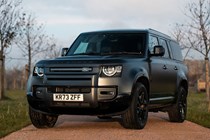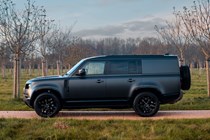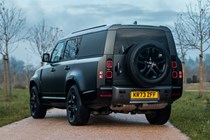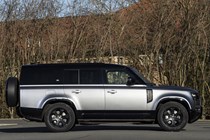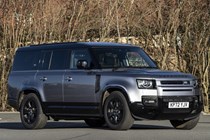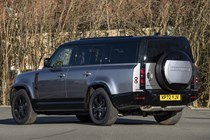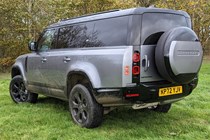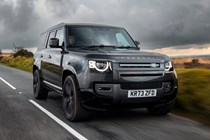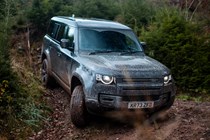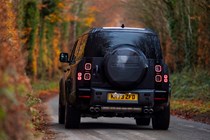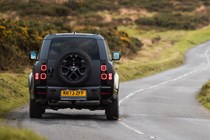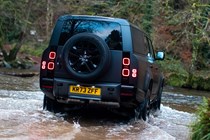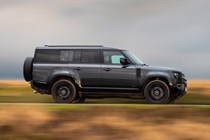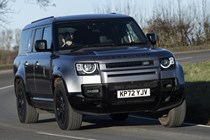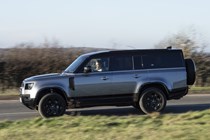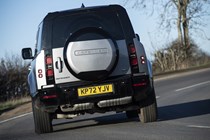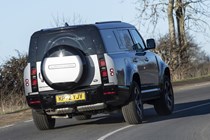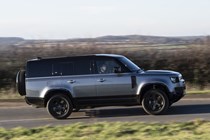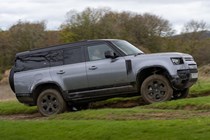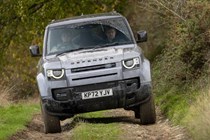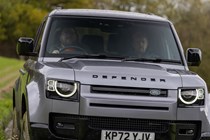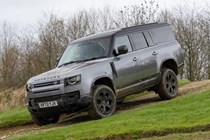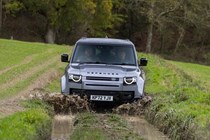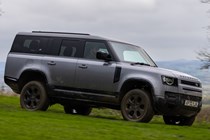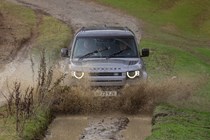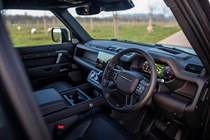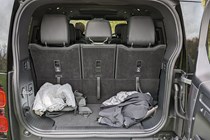
Land Rover Defender 130 review
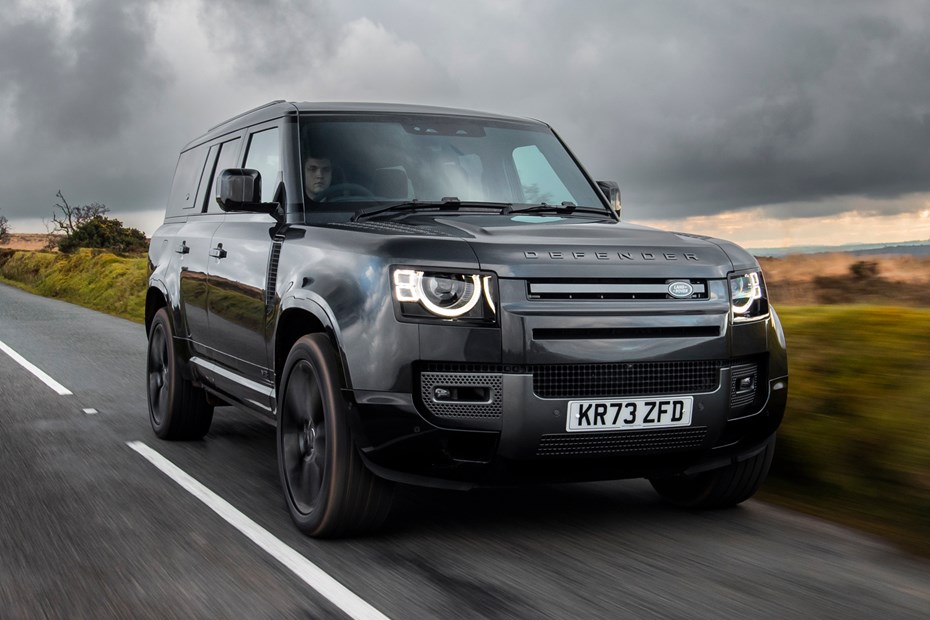
At a glance
| Price new | £84,735 - £122,930 |
|---|---|
| Used prices | £44,760 - £97,900 |
| Road tax cost | £620 |
| Insurance group | 41 - 50 |
Get an insurance quote with

|
|
| Fuel economy | 19.1 - 32.8 mpg |
| Miles per pound | 2.8 - 4.2 |
| Number of doors | 5 |
| View full specs for a specific version | |
Available fuel types
Petrol
Diesel
Pros & cons
- Space inside for eight adults!
- Enormous boot in five-seat mode
- Virtually unbeatable off-road
- Massive size is tricky in town
- Options quickly inflate the price
- An MPV is better at carrying people
Land Rover Defender 130 rivals
Overview
The original Land Rover Defender was a strong, dependable workhorse for strong, dependable people. You know, such as farmers and mountain rescue teams. Folks that are happy to sacrifice a bit of comfort in the pursuit of rugged capability. But when Land Rover launched the new Defender in 2020, it shook off the car’s blue-collar roots and turned it into more of a country-chic status symbol.
And none of the models in the new Defender’s line-up respect that branding as well as the 130. It’s the daddy – the flagship, long-wheelbase model, perched right at the top of the car’s line-up. It offers enough space inside to seat an entire rowing team and enough technology to embarrass any BMW owner at the golf club – but it’s still sturdy enough to tackle even the toughest green lane without breaking a sweat.
Rivals for the Defender 130 are pretty limited – and you can instantly understand why when you pass one. It’s big. Almost too big for our roads, in fact. Still, there are some luxury seven-seat SUV competitors out there, with the main ones being the long-wheelbase Range Rover, the Land Rover Discovery, the BMW X7 and the upcoming replacement for the Toyota Land Cruiser.
But the question is, is the Defender 130 worth considering over the Defender 110? Both cars have the same wheelbase, with Land Rover merely fitting a larger body to afford the extra space inside for the flagship model. The 110 is also available with the same level of equipment and seven seats (which means it’s very nearly as practical for most buyers). Plus, its starting price is a good £20,000 less. Scroll down to find out more.
What’s it like inside?
For the driver, it’s almost exactly the same as the Defender 110. The most noticeable change is that the bodywork occupies more of the space in your side mirrors. Otherwise, it’s identical – which is to say comfortable, upmarket and well appointed. We’re especially fond of the chunky switchgear on the centre console and Land Rover’s crystal-clear 11.4-inch infotainment system.
The 130 makes far better sense for passengers. The 110 is a standard five-seater, with a pair of optional jumper seats in the boot (which are a little cramped for adults). But the 130 is an adult-sized eight-seater, offering tonnes of room everywhere. Even the third row has plenty of legroom and headroom. Plus, everyone gets a great view out thanks to big windows and a standard panoramic sunroof.
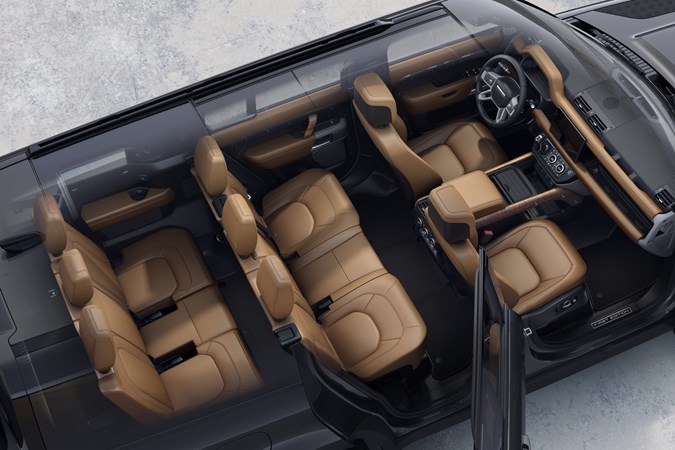
Better yet, there are five Isofix child seat mounting points – one in the front passenger seat and two in each rear row. You will need to be quite limber to sit in the third row, though. The second row of seats slide forwards to provide access, but the aperture they leave is quite narrow and you need to haul yourself up the car’s not inconsiderable ride height.
But because the 130 is so vast, it can offer seating for eight and it still has enough spare room in its body for a decent-sized boot. With all three rows of seats in place, you get 389 litres of luggage capacity, which is about the same as a Volkswagen Golf. Fold the third row flat and space expands to a cavernous 1,232 litres – and if you tumble all the seats forwards, there’s a van-like 2,291 litres.
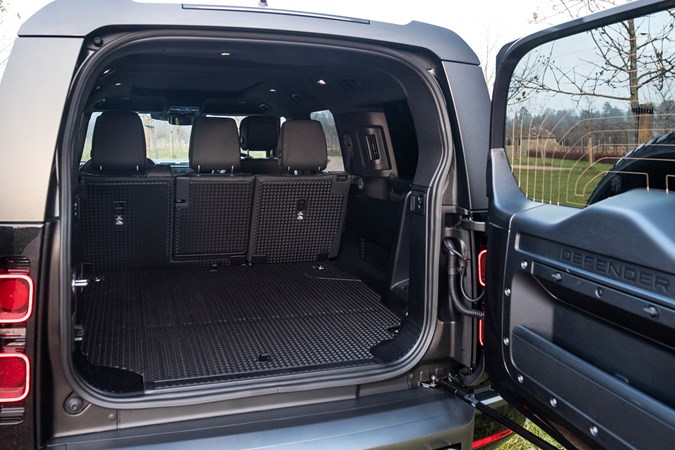
Both back rows split in a 40:20:40 configuration, too, which makes it easy to adjust passenger and luggage space as needed. Sadly, the floor isn’t totally flat. The rear seats leave a lump when folded. However, if you want the maximum amount of boot space for your money, you can opt for a five-seat-only configuration – with an even larger boot – for no extra cost.
Land Rover Defender 130 engine range
When the Defender 130 first went on sale, Land Rover only offered it with its inline six-cylinder petrol and diesel engines. They both produce 300hp, they both feature mild hybrid assistance and they’re both paired to an excellent eight-speed automatic gearbox.
When we drove the D300 diesel, we found it to be a good match even for the Defender 130’s vast bulk. It’s not what you’d call quick, but it’s muscular enough to pick up its skirts and get moving when required.
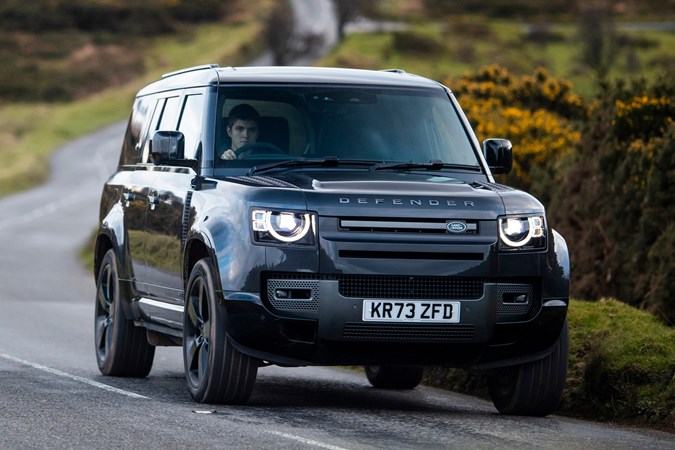
Land Rover claims the diesel 130 can return up to 31.6mpg on the combined WLTP cycle, while emitting 235g/km of CO2. We tested the car over a week and averaged 28mpg – not as awful as we might have expected, but still significantly less efficient than, say, a diesel BMW X7.
More recently, Land Rover added its 525hp supercharged V8 petrol engine to the Defender 130 range. Unsurprisingly, it’s the least efficient engine of them all, with claimed figures of 19.6mpg and 325g/km. We couldn’t match that. During a day of admittedly tough off-roading and lots of stop-start traffic, we averaged 16.5mpg. It performs better on a long motorway drive at consistent speeds.
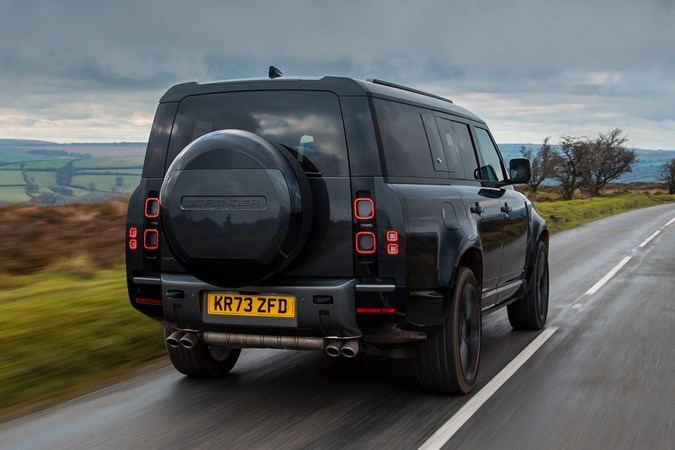
There’s a benefit to such excessive consumption, though. Excessive speed. 525hp is more than enough to shuffle the 2,645kg Defender 130 along at an alarming pace. Precious few cars provide the opportunity for seven passengers to be sick in unison – but Land Rover has delivered. Plus, the engine’s mountain of pulling power means that it barely breaks a sweat when you load it with bodies and luggage.
It sounds great, too. The deep bass rumble from the exhaust from the exhaust accompanied by the tenor whine from the supercharger only adds to the cheeky feeling of piloting a near three-tonne SUV in cash-strapped Britain. It’s perhaps a little more muted than we would have liked, but it’s still enormous fun.
What’s it like to drive?
The diesel Defender 130 feels an awful lot like the equivalent Defender 110 to drive – which is to be expected because the two cars are virtually identical apart from the bodywork. Just like its smaller siblings, the 130 corners admirably well for something so vast, providing you take a smooth and flowing approach to bends. The car’s standard air suspension does a great job of propping the bodywork up, so it never feels too soft or wallowy.
The V8 is a different kettle of fish, though. The atomic amount of performance lurking under the bonnet really tests the limits of physics, which means you need to be even more cautious about your cornering strategy. Push too hard and you’ll chart a course into the undergrowth (which probably isn’t as serious as it sounds, given the Defender’s formidable off-road ability).
We’ve conducted extensive testing of the Defender V8’s handling characteristics on some of Cumbria’s toughest fell roads – and we think we have the cornering tactic nailed. Start by approaching the corner at a slightly lower speed than you would in a normal car. Then, throw the wheel into the bend and allow the suspension time to lean and settle.
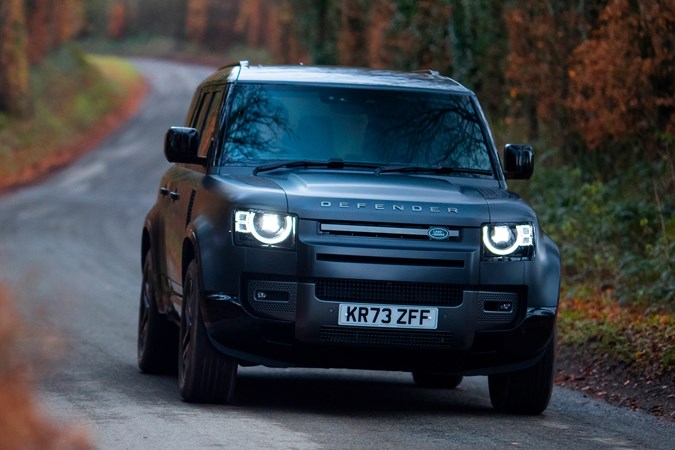
Finally, sight your exit and use the V8’s colossal pulling power to blast towards the next turn. Using this method, you’ll find you can keep pace with some of the fastest hot hatchbacks on sale, which is mightily impressive for a crag-crawling off-roader.
The Defender’s steering system is quite light at low speeds, but the resistance builds as you pile on the speed – and the change in assistance is very gradual and progressive. It feels completely natural. You even get a reasonable amount of feedback through the wheel, which further helps inform you where the front wheels are pointing when you’re pressing on.
Surprisingly, for a car that’s so unstoppable off-road, the Defender 130 is remarkably comfortable on the motorway, too. This trait was especially impressive on our V8 test car, which came fitted with gargantuan 22-inch alloy wheels. You can’t have it all, though. Those huge alloys produce some tyre roar at speed and the ride is a little fidgety around town. Neither are offensive, though.
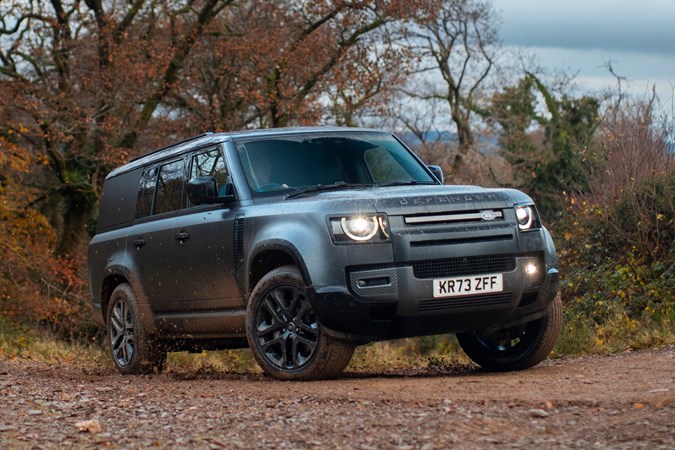
And now to address the as-yet ignored elephant in the room. Iit should come as no surprise that the Defender 130 is a dab hand at mudplugging – much like its smaller siblings. Naturally, it’s a little heavier and, with its longer body, it doesn’t have quite as impressive a departure angle as the 90 or the 110. But you’re still very unlikely to get stuck on anything the British road network can offer.
In most cases, off-roading in any Land Rover is simply a case of selecting the correct drive mode, pointing the car where you want it to go and allowing the arsenal of off-road assistance systems to figure out how to keep the car moving – and the 130 is no exception. It’s all very seamless.
There is always a weak link, though – and in our case it was the all-season tyres our 130 was fitted with. They grip well on tarmac but, because they have quite a mild tread pattern, they soon go slick with mud off the beaten track. As a result, we managed to get the car stuck down a muddy green lane. However, simply putting a chunk of rock under one wheel was enough for the traction control system to figure out how to pull the car free.
What models and trims are available?
Most of the standard Defender’s trims are available on the 130. The range opens with the X-Dynamic SE, passing through the more generously appointed HSE model before arriving at the all-singing, all-dancing X variant. There’s also an Outland edition, which offers the 130 body in a five-seat configuration for people who need the enormous boot but not the seven seats.
If you’re concerned that the low-spec models are basic, fret not. You still get 20-inch alloys, LED headlights, 12-way electrically adjustable and heated front seats, a panoramic sunroof, a Meridian sound system, 360-degree camera and 11.4-inch touchscreen infotainment right from the off.
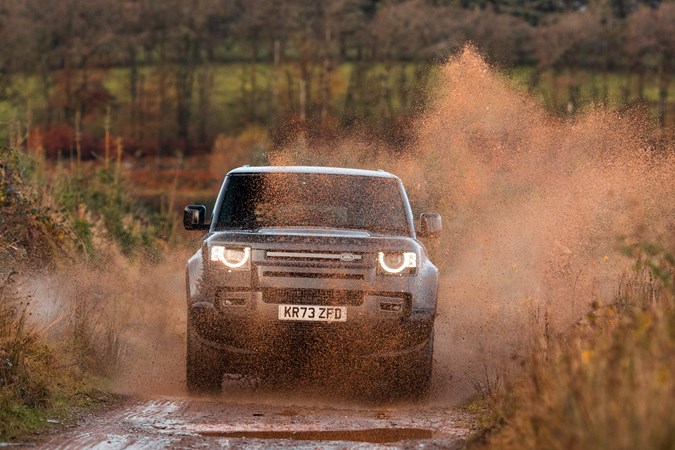
You can also specify a host of extras such as Land Rover’s ClearSight interior mirror/rear-view camera, real leather upholstery and Matrix LED headlights. They’re optional on the most basic SE model but fitted as standard on the top-spec X car. The Defender V8 also has its own dedicated specification, complete with a set of unique 22-inch alloy wheels, surround sound audio and tinted tail lights.
What else should I know?
Don’t put a Defender 130 on your shortlist until you’ve familiarised yourself with its dimensions. At over 5.3m long and more than 2m tall, it’s bigger than most pickup trucks and longer even than some large panel vans. You’ll need a massive garage or extensive driveway to keep this at home, and street parking is likely to be a nightmare if you live in a busy city.
It’s also worth considering the price. If all you need are eight seats, a large MPV such as the Volkswagen Multivan will suit your needs for much less money. The Defender 130 starts at a whopping £73,895, and you can easily add £20,000 to that if you make merry with the options list.



